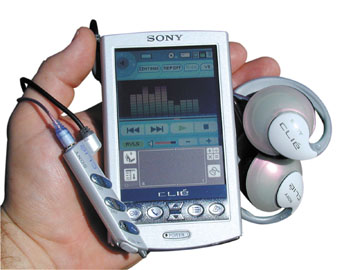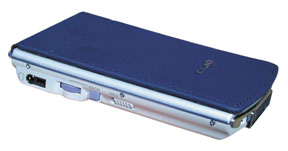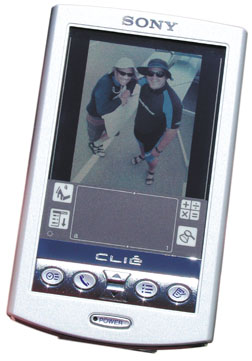Sony CLIE PEG-N710C
Sony does color right and adds audio
by Shawn Barnett

July, 2001
While the original monochrome Sony CLIE was slim, comfortable, and the first to include the Memory Stick, it's with the new CLIE PEG-N710C that we see the legendary Sony design house at its finest. With its 320 x 320 reflective color screen, Memory Stick slot, and built-in MP3 player, it sets itself apart from competitors, excelling even over Pocket PC machines in some areas. And it's all held together by the ease and intelligent design of the Palm OS.
The N710C comes with a few more peripherals than other Palm OS devices, including stylish clip-on earphones, a special audio controller/stylus, and an 8MB Memory Stick. You also get a good bundle of software, including PictureGear Pocket image and movie viewer software, and OpenMG for managing your images and uploading audio files to your Memory Stick.

Walkaround
The N710C comes with a rubbery blue flip cover instead of the clamp on case that came with the S300. It snaps on with a chromed plastic bar using two holes at the top of the device. It flips open and is hinged to lay flat on the back, though it blocks the IrDA port, Memory Stick slot, and the conventional stylus, so it can be cumbersome at times. It closes at the front with a magnet, the first magnet I've seen used on a small electronic device.
The Memory Stick is released by pressing down, and it rises higher than its previous position for easier removal, just like the new SD cards do. It is spring-loaded, so it can also launch the light and small Memory Stick a few feet if you're not careful. Right next to the slot is something missing from other Palm OS PDA's: an activity light, showing when data is being read or written. When the stick is removed, a door flap closes to keep foreign matter out, another first for this platform, and a very good idea.

Also on top is a small metal swivel with a wire loop for attaching a lanyard or wrist strap, which is not included.
On the upper left side is the audio input port-a standard 1/8 inch headphone jack-and the very non-standard square stylus/controller connector. Because the improved Jog Dial is below these two connectors, it is lower than on the S300, and it requires a little more bending of the thumb to reach. It is made more convenient overall with the addition of the adjacent backout button, so not only can you drill down into programs by pressing in on the JogDial, you can move back out of them without using the stylus. Finally, below that is the Hold switch. This turns off the screen and all other controls when playing audio to avoid accidental activation when in a pocket.

On the bottom is the same 13 pad connector we saw on the S300, only with slightly different mating surfaces, meaning sled-type peripherals for the two devices will most likely be incompatible. The plastic here is also chromed.
The back is made of plastic and has only the reset button and a notch to lock the unit down in the cradle. It is deeper than the Palm V/m500, and tapered at the sides, and as such it fits in the hand very comfortably, actually touching the palm. The m500's are thinner, but flatter, making contact only at the sides. Because the CLIEs are also narrower when viewed from the front, they remain the most comfortable to hold, providing three major points of contact with the hand: thumb heel, fingers, and high points on the palm.
The front is very different from the S300, moving away from the striking metallic slab sides to a lighter metallic bezel all around. The material looks identical to the plastic back, but it is magnesium. The Sony logo is a shiny, raised, cut plastic similar to the logo on Palm m500s. The power button is moved from the top to the very bottom front center, and a green LED indicates when the unit is on (important for when the hold switch is on, since the screen is not an indicator of power status in that case). This button sometimes sticks, causing the frontlight to turn off or on.
The four major program access buttons are arrayed on a matte chrome bar, with a flared rocker in the middle. Above that is the single chrome name badge with "clie" in the center. The Graffiti area is identical to the S300, only with a darker grey background and white icons. It is not backlit like the m505.
The cradle is small and understated, and the power cable can be removed and taken with you to recharge the unit on the road. My only complaint about the cradle is that it's a little too light, sometimes making the N710C difficult to remove.
Power it up
That's just what Sony did, which you'll discover when you press the power button. The first difference you discover is the razor sharp display. 320 x 320 in such a small space makes for very small pixels, and Sony's smallest font is indeed razor thin. It may be a little too thin, but it's readable. Unlike HandEra, Sony didn't take as much advantage of the higher resolution. While they did remap the fonts to be smoother overall, they only offer three, while the 330, despite its lower resolution of 240 x 320, offers eight. The 330 also smooths out the icons, where the N710C retains the standard, jaggier icons, even among programs that are written specifically for this device.
Still, the display is beautiful. As it ships with OS 3.5.2, it can only display 4,096 colors, but when 4.0 is released for the Sony I'm told it will support 64K. As it is, images look great, both indoors and out.

Photographs have finally arrived on the Palm platform with the N710C, exhibiting fewer compromises. More pixels mean more detail, and this small device beats even the Pocket PC for clarity. At a distance of ten inches, no pixels are evident at all when viewing photographs, a remarkable improvement. While the brightness and contrast does not equal that of a Visor Prism indoors, a quick trip outdoors will demonstrate which is superior overall, for the Prism will go black, while the N710C will stay roughly the same. Compared to the new Palm m505, which uses similar reflective screen technology, the N710C works in more lighting situations, always appearing with a near-paper-white background, the Holy Grail in this industry. To paraphrase Monty Python's French Taunter, "They've already got one, you see? It's very nice."
Also unlike the m505, brightness is adjustable. It doesn't get as bright as the Compaq iPaq, which also uses Sony screen technology, but it's also not as dependent on the wall socket for recharging. The N710C is always available for both data and fun, indoors, outdoors, in complete darkness or full sunlight. The only main compromise with this technology is the lack of contrast due to the frontlighting, which tends to light up the glass at its brighter settings. Finer pixels have a harder time making an impression through the partially lighted glass.
Listen to this
Another feature no other Palm OS computer offers out of the box is MP3 playback. Sony did this very well, embracing both its proprietary ATRAC-3 format, the standard used on its MiniDiscs, and MP3, the technology made most famous (some would say infamous) by Napster.
The earphones included with the N710C are both beautiful and comfortable, even though they actually clip onto your ear. Most headphones hurt my ears, especially the ones that fit inside your ear, but these are comfortable for hours of wear. They have a pearlized dome for good looks, and can be plugged into the controller/stylus or directly into the jack, though the cord is somewhat short for this. When you plug it into the controller, the combo is four foot six inches to the first earpiece; by itself, it's only one foot eleven inches. The stylus/controller has another hold switch, a playback and stop rocker, a forward and reverse rocker, and a volume plus and minus rocker. It also has a small stylus tip, which could be about an eighth-inch longer for my use, and a pen-style clip for a shirt pocket. Of course, the only impediment is the cord itself, making the bundle a little difficult to store without snarling, but little trouble when you've figured it all out-until you have to put it away again. You'd have this trouble with any MP3 player, though without the stylus to complicate matters. The special stylus I could take or leave, but you can adjust the volume and change tracks while running other programs with the stylus controller, so it definitely has a place in the overall design.
The Audio Player screen is baby blue with a dial icon in the upper left corner that tells you what functions are currently available via the Jog Dial. Pressing in on the dial allows you to change the setting. A battery icon is wisely displayed right next to that (Sony claims 11 hours of MP3 playback with the Hold switch on). It is followed by the file type indicator, a source indicator (Memory Stick or Internal) and a display mode selector. You can stay in title view, which shows the track number, time played, song title, and artist, or go to the VU meter display or list view. I get the impression that interface skins will be available in the future to change the look.
My biggest disappointment with the Audio Playback feature was that I couldn't go to other applications while listening, but I eventually found the option to "Enable background playback," and I was once again really happy with the N710C. You can even copy to and from the card with little or no interruption in the audio stream. The only interruptions I found were when the MS Gate program-which accesses the FAT directory structure of the cards-was scanning all directories on first access. The stream was likely interrupted when the scan operation came across the file that was playing. I could otherwise copy files and view them while the audio continued uninterrupted. Audio playback is achieved with a DSP, or Digital Signal Processor, in addition to the standard 33MHz Motorola Dragonball VZ processor.
Access
To play ATRAC-3 files, you need a MagicGate card instead of a Memory Stick, since files are "checked out" from your desktop and can only be copied back to the same machine. MP3 files can be copied to either type of card via the standard Windows Explorer, accessing the Memory Stick through the cradle as though it were a hard drive.
This is a rather ingenious method of copying files over, one which should be on all Palm OS devices. It allows one to install program and data files as well as music files. The Palm m500, which runs OS 4.0, can actually HotSync directly to the card, and this is Sony's workaround for OS 3.5.2's limitation in this area. It is actually better because you can send just about anything to this card, fulfilling-or at least supplanting-my desire for a "digital pocket" for transferring files from home to office with my handheld. With the N710C you get not only a handheld, but a Memory Stick reader for your PC. Very nice.
Files can be viewed and moved from cards to internal memory with the MS Gate program (short for Memory Stick Gateway). It uses a tree structure similar to the HandEra 330. You cannot select directories by tapping on the name, however, you have to tap on the folder icon next to the name. It's a bit of a nuisance. While you can move files from a Memory Stick to memory and vise versa, you cannot move files from one directory to another on the card, which is also a little frustrating.
Programs can be run from the Memory Stick by copying them over and associating them via the MS Autorun application. Instructions on this are a little less than clear with the beta unit and manual I received, so I was only successful in associating an application, in this case PictureGear Pocket viewer on the MS with insertion of image files. When inserted, the PictureGear Pocket application is launched, but the user must still switch to the Memory Stick from within that program for images to be viewed.
Videos are also viewable from the Memory Stick using the gMovie player. Users can download trailers for Sony movies to the device. I tried this, but was disappointed by incompatibility with my device's version of the gMovie player and the new videos available on Sony's site. The included video file of a bear walking through a field worked fine, as did the video of two girls walking by.
Performance
I'm not sure if it's because of the higher resolution screen, but even the basic apps come up a little sluggishly when compared to just about any other Palm OS machine, including the Palm V. Since it's using the same processor as the other new machines, that appears to be the only variable.
HotSync is very quick, maybe a little slower than the m500, but about on par with the Visor line.
Games play very well on the N710C, with no compatibility problems. You can select to turn on High Resolution Assist in the Preferences menu, which can give legacy programs access to the finer fonts available with the CLIE. Games do not work well, with this, though, so you're able to select individual applications that you do not want to benefit from this help. Both Ace and Zap!2000 balk at High Resolution Assist, displaying two screens side by side in the top one-sixth of the screen. A quick checkmark in the HiRes Prefs window eliminates the problem. Programs like Wordsmith have no trouble, adapting to the new fonts easily, even maintaining the smooth scrolling available with the JogDial.
The one factor that will keep me from making the Sony a daily carry is that it can't coexist with other Palm OS devices. Once you've installed Sony's Palm Desktop, no other Palm OS devices HotSync, including serial port devices, Handspring Visors and the new Palm m500 line. Those who use only one device per computer will have no problem, but users who plan to hand down their existing device to a spouse or child will be disappointed. I review far too many other Palm OS devices to handle this kind of incompatibility.
Overall, however, Sony has created an excellent handheld whose primary benefit is useable color in all lighting situations. Its ability to be used as a multi-purpose storage and multimedia player increases the value exponentially. For US$499, it's a bargain.
-Shawn Barnett
Questions? Comments?
Back to Palm Section

